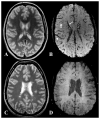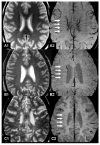Diminished visibility of cerebral venous vasculature in multiple sclerosis by susceptibility-weighted imaging at 3.0 Tesla
- PMID: 19388109
- PMCID: PMC2818352
- DOI: 10.1002/jmri.21758
Diminished visibility of cerebral venous vasculature in multiple sclerosis by susceptibility-weighted imaging at 3.0 Tesla
Abstract
Multiple sclerosis (MS) is a disease of the central nervous system characterized by widespread demyelination, axonal loss and gliosis, and neurodegeneration; susceptibility-weighted imaging (SWI), through the use of phase information to enhance local susceptibility or T2* contrast, is a relatively new and simple MRI application that can directly image cerebral veins by exploiting venous blood oxygenation. Here, we use high-field SWI at 3.0 Tesla to image 15 patients with clinically definite relapsing-remitting MS and to assess cerebral venous oxygen level changes. We demonstrate significantly reduced visibility of periventricular white matter venous vasculature in patients as compared to control subjects, supporting the concept of a widespread hypometabolic MS disease process. SWI may afford a noninvasive and relatively simple method to assess venous oxygen saturation so as to closely monitor disease severity, progression, and response to therapy.
Figures




References
-
- Filippi M. Multiple sclerosis: a white matter disease with associated gray matter damage. J Neurol Sci. 2001;185:3–4. - PubMed
-
- Haacke EM, Xu Y, Cheng YC, Reichenbach JR. Susceptibility weighted imaging (SWI) Magn Reson Med. 2004;52:612–618. - PubMed
-
- Poser CM, Paty DW, Scheinberg L, et al. New diagnostic criteria for multiple sclerosis: guidelines for research protocols. Ann Neurol. 1983;13:227–231. - PubMed
-
- Wilson DL, Noble JA. An adaptive segmentation algorithm for time-of-flight MRA data. IEEE Trans Med Imaging. 1999;18:938–945. - PubMed
Publication types
MeSH terms
Grants and funding
LinkOut - more resources
Full Text Sources
Medical

